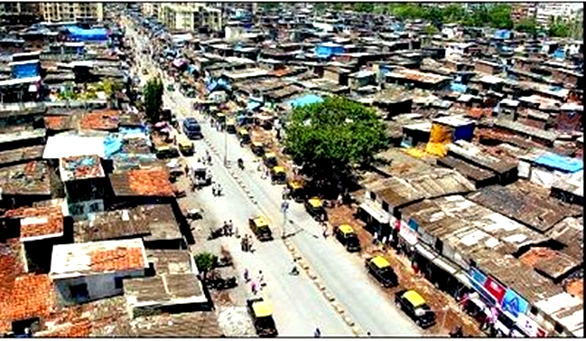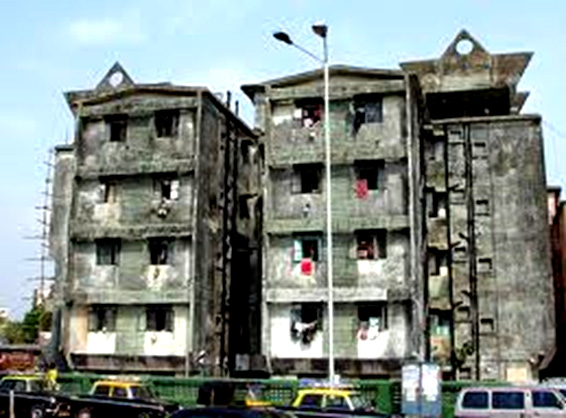
There are two ways to get to Dharavi – Take the Western Railway/ Harbour line local from any station, get down at Mahim Railway station and cross over from the east into Dharavi Or take the Central Railway local, get down at Sion railway station and drive down the Mahim Creek into the heart of Dharavi on the single road connecting the Mahim railway station. Whichever way you choose, You will be greeted by the stench from the Mahim creek which stays with you till you are out of Dharavi.
History of Dharavi
Dharavi means ‘loose mud’ in the Tamil language. It might have got this name as 18th Century Dharavi was an island and a mangrove swamp, inhabited by the Koli fishermen. The Fishing Industry disappeared after the swamp areas filled up. A dam at ‘Sion’ hastened the process and the newly drained marshes provided space for new communities to move into the area..
Migrants from Gujarat established the first potter’s colony, followed by Tanners from Tamil Nadu and Maharashtra who set up the Leather Tanning Industry in Dharavi

The next community to settle in Dharavi were the Embroidery workers from U.P. who were mostly Muslims and masters in their craft. The leather Tanning industry gave rise to the brewing of illicit liquor and boot legging and Dharavi became the refuge for criminals and Mumbai;s Underworld.

The most important reason for the migrants to choose Dharavi to settle was availability of cheap and unauthorised land in the centre of Mumbai, then called ‘Bombay’ – The city of opportunities and the commercial capital of India.
In addition to the traditional pottery, textile and tanning industries, there is an increasingly large number of Recycling Industries which convert metal scrap, plastic waste and other scrap into new products
Present Day Dharavi
Present day Dharavi is a slum spread over Sion, Bandra, Kurla, and Kalina suburbs of Mumbai, between Mahim in the west and Sion in the east covering an area of 175 hectares or .67 sq miles
There is an estimated 5000 businesses and 15000 single room factories, most of them small scale or Cottage industries with an annual turnover of US$ 665 million. Dharavi has a population of over 1 million. 90% of the commercial units and most of the housing is illegal.
Dharavi has severe problems with Public Health. As per a survey in 2006, it was found Dharavi had one toilet for every 1440 residents. There are very few public toilets and the nearby Mahim Creek is used as a Urinal and for defecating. Dharavi also has inadequate drinking water supply as more than 15 families have to share one common tap.
Dharavi got its first school (and first Tamil school) in 1924 and it was the only school for the next 4 decades. To-day Dharavi has more than 10 schools in the area like The Ganesh Vidya Mandir(only Marathi medium school), Ambedkar school, Shri. Shri. Ravishankar Vidya Mandir, S.L. Anthony’s English School, B.S.I.A.S. English High School, Kamban High School and others
Dharavi has also become famous thanks to its underground connections starting from Varadarajan (the Matunga Don) to Haji Mastaan to Dawood Ibrahim. Dharavi has also been the background for many of the Bollywood, Tollywood and even Hollywood films, which have romanticised the exploits of the gangsters. The Tamil Film Industry was the first to depict the exploits of gangster, Varadarajan in a film titled ‘Nayakan’ and the role of Varada was essayed by the famous actor – Kamalhasan. Bollywood followed up with ‘Deewar’ (Amitabh Bachan), ‘Parinda’ (Anil Kapoor), ‘Bombay’, ‘Sarkaar’, Black Friday’, ‘Amir’, etc., Even Hollywood’s famous Director – Danny Boyle has Dharavi as the background for his Oscar winning ‘Slum Dog Millionaire’
Dharavi has also become a ‘Tourist Destination’ and tourists coming to Mumbai can visit Dharavi through ‘Reality Tours’ conducted by Tour operators, who show tourists the miserable life of the slum dwellers and their grit and determination to come out winners against all odds, including the Government’s apathy.
The Dharavi Re- Development Plan
Now that the World’s attention is focussed on Asia’s largest slum – Dharavi, the Government has decided to re-develop the slum and improve living conditions for the slum dwellers and the original inhabitants who have turned a swamp into a ‘hot property’.

The Dharavi Redevelopment Plan (DRP) envisages the division of Dharavi into five sectors. Bids were invited from a consortium of international and national developers to provide free housing and infrastructure for the residents of Dharavi. The Developers had to pay a premium to the Government and in return get as incentive ‘Floor Space Index’ (FSI) on which they could build more commercial and other structures and sell in the open market. In this way, it was to be a win- win situation for all the parties concerned. The Government would earn substantial revenues, the Developer would make windfall profits and the residents of Dharavi would have more living space and better amenities than before. However, the DRP was shot down by the Committee of Experts for Dharavi Redevelopment Plan, appointed by the Government of India.

“ This view has also been supported by the slum dwellers associations and the residents of Dharavi.
The stalled DRP has been again revived by the present Maharashtra Chief Minister, Shri. Prithviraj Chavan, who announced that the first phase of the DRP and work on Sector 5, would be started soon. As per the plan, The ‘Maharashtra Housing and Area Development Authority ( MHADA ) will be the nodal agency for the project. The FSI has been increased to 4 from 2.5 to make the project commercially viable. MHADA will commercially exploit the remaining FSI after rehabilitating around 9000 families living in Sector 5. The Government has still not taken any decision on the remaining portion of land in the other sectors of Dharavi, which is largely private land.
“This is not a Greenfield Operation but a Brownfield one in which slum dwellers need to be involved in the process rather than relying on political power” says Jockin Ariputham, President, National Slum Dwellers Federation. “MHADA is a housing body and does not have expertise in Slum Re-Development”.
The question being asked by the people is “should land be seen primarily as a source of revenue for the Government and profits for the Developer?”.
Prince Charles on one of his visits to Mumbai has said that “Dharavi was a unique self contained Township and not a Slum. It offered a better model than Western architecture for housing a booming urban population in the developing world. ‘Dharavi” he said with” its use of local materials, walk-able neighbourhoods, and a mixture of employment and housing, represents a design totally absent from the faceless slab blocks that are still being built around the World to ‘ warehouse the poor’.”
LSW is of the view that, the Government’s role in re-developing Dharavi should be restricted to treat Dharavi more as a self sufficient village in the heart of Mumbai and only provide the basic necessities to its residents, like drinking water, sanitation, electricity, schools, Hospitals, proper roads, parks and playgrounds and proper policing to maintain law and order and prevent criminals (Underworld) taking control of the area, thus allowing the residents to carry on their economic activities as before and contribute to the economy.
This will make Gandhi’s dream of ‘a self sufficient and self sustaining village community come true’.
S.G.B.Rao, LSW Lifescienceworld
www.lswlifescienceworld.com